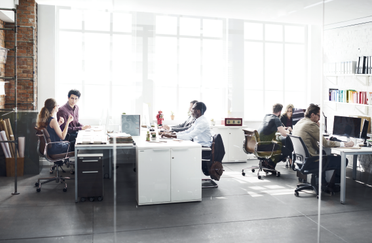The right light for open-plan offices
 | It's the most common type of office layout, accommodating a lot of different people doing a lot of different things. That means lighting for open-plan areas is about striking a balance. Here's how to get it right, with inspiration from best practice projects. |
Open-plan areas are the most common type of office layout. And with workplaces becoming more flexible and less formal, it seems open-plan is here to stay. Today’s open-plan offices must cater to remote and occasional workers as well as regulars. Even workers who are mainly desk-based may be using portable devices, and may not be at the same desk every day. From a lighting perspective, open-plan offices require a balanced approach: sufficient light for a variety of tasks being performed individually at desks, but also appropriate lighting for circulation areas and areas where people may talk face-to-face, and a positive atmosphere and appearance for the space as a whole. The absence of internal walls means open-plan areas are likely to be lit mainly with ceiling-mounted fittings. The workplace lighting standard EN12464 specifies luminance levels for various tasks, including desk-based tasks and filing. But activities in an open-plan area are many and varied, so a degree of judgement is needed from the person planning the scheme. A good way to build flexibility into your design is to put control in the hands of employees.
Research has shown that the more control people have over their workplace lighting, the more satisfied they are at work. This can be done by giving workers a degree of control over the illumination in their area, or by adding individual task lighting. It’s vital to make sure there is good lighting for all tasks taking place in an open-plan office, as defined in the EN12464 standard. But that’s not the only thing to think about. We must also consider how we like the space around us, creating an environment where workers feel comfortable and alert. Face-to-face communication is increasingly important in the modern workplace. Lighting needs to create an environment where people feel comfortable, look good, and can read each others’ expressions and body language. Good lighting of faces requires sufficient vertical and cylindrical illuminance, which you’ll get from diffuse lighting that illuminates walls and ceilings. By considering carefully how light fits into the modern workplace, contractors, specifiers and designers can add considerable value for clients, helping to create a healthy, happy and positive working environment, which pays off through the productivity and loyalty of employees.
| TOP TIPS | EN12464 |
• Refer to the standard and provide | THE STANDARD SPECIFIES |
